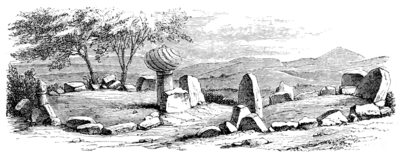pagan population, who elevated these vast ranges of stone to arrest the invading host." Or, again, they even name the prince who opposed the conquerors. Thus (page 117): "Formerly at Machira lived a pagan prince called Abd en Nar—fire worshipper. He married Zana, queen of a city now in ruins bearing that name. When the Arabs conquered Africa, Abd en Nar abjured his crown, became a Mussulman, and from that time called himself Abd en Nour—worshipper of the light."[1]
This, too, must be taken for what it is worth; but in a cemetery near Djidjeli, on the north coast, there is a curious tomb formed of a circle of stones like those of the pagan cists, with a headstone which, if it is not the turban-stone that is usually found in Turkish tombs of modern date, is most singularly like it. That the cemetery belongs to the Mahommedans seems clear, but the circles of stones, though small, indicate a very imperfect conversion—just such as the tradition indicates.
These arguments, however, acquire something like consistency when we come to examine the contents of the tombs themselves. One of them (No. 4) is described by Mr. Féraud as surrounded by a circular enceinte, 12 metres, nearly 40 feet, in diameter. The chamber of the dolmen measured 7 feet by 3 feet 6 inches. At the feet of the skeleton were the bones and teeth of a horse, and an iron bridle-bit. In the same grave were found a ring of iron, another ring with various other objects in copper (bronze?), some fragments of pottery of a superior quality, and fragments of
- ↑ 'Mémoires, &c., de Constantine,' 1864.

